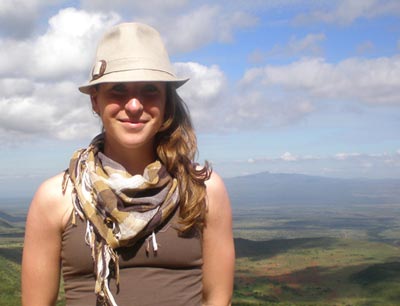 |
| Dal student Emily Meisner set up her own work term in Kenya.(Photo courtesy of Emily Meisner) |
For Emily Meisner, it was a dream come true: meeting the world cross-country and world half-marathon champion Lornah Kiplagat, whose picture has been stuck to her bedroom wall since she was eight years old.
Talking to the Kenyan long-distance runner and touring her high-altitude training camp was a highlight of the Dal studentās self-made summer work term in Kenya.
āI know itās a cliche to say you come back changed, but I did come back changed,ā says Ms. Meisner, a fourth-year kinesiology student. From the tiny village of South Brookfield, the Nova Scotian always wanted to go to Kenya and so she did, landing in Nairobi with nothing but a backpack and the telephone number of a professor at Kenyatta University. She stayed for 10 weeks, working at a summer camp for children with disabilities and developing physical activity programs for the community through the universityās sports science department.
Yoga class
She laughs as she relates how she managed to lead a noon-time yoga class, despite her struggle to wrap her tongue around Swahili. After about 45 minutes of introducing poses to the 15 assembled people, she finished with the ācorpse,ā a basic relaxation pose that entails breathing exercises while lying flat on the floor. Afterwards, as she thanked everyone for coming, she realized the room was eerily quiet.
āIām like, āOkay! Thanks very much! Thanks for coming!āā recalls Ms. Meisner. āAnd then Iām thinking, āDo they know class is over?ā And thatās when I realized everyone was fast asleep.ā
As a long-distance runner with Dalhousieās varsity cross-country team, she discovered running was something she had in common with many Kenyans. While overseas, she was keen to take advantage of training opportunitiesāand attempt to unlock the secret of why Kenyans lead the world in long-distance running.
At Kenyatta, she met Mike Boit, a former middle-distance running champion and director of physical education at the university. A bronze medallist at the 1972 Olympics in Munich, Mr. Boit invited Ms. Meisner to his rural village, located in the lush, equatorial highlands where so many of Kenyaās swiftest runners come from. There, she met Mikeās cousin Philip Boit, the only Kenyan to compete in the winter Olympics, and Lornah Kiplagat, a world record holder for the 5K, 10-mile, 20K and half-marathon.
Olympians
āIt was amazing to meet these Olympians. Here they are in their modest homes and theyāre still planting their own gardens and milking their own cows,ā she says. Philip Boit, for example, is a farmer who started his sporting life as a middle-distance runner but switched to cross-country skiing in the mid-1990s with the support of Nike. The skier, who does his dry-land training on roller skates over muddy, rutted paths, has since competed in four winter Olympic games including Vancouver.
Ms. Kiplagat also grew up on a farm in the Rift Valley. Although now a Dutch citizen who lives part of the year in Holland, she has never forgotten her homeland where she built the first womenās training camp, 8,000 feet above sea level. Since opening the camp in 2000, sheās added a boarding school so girls can train and keep up with their academics.
The high altitude has something to do with why Kenyans run so far and so fast; it gives them strong lungs and helps with their endurance. But thereās another reason, as Ms. Meisner discovered while training with a member of Kenyatta Universityās track-and-field team.
No limits
āAn easy run for him was killer for me,ā she says, adding that their route would include going up muddy hills and through creeks. āI asked him what he thought and he said, āWe donāt have limits. We donāt have marked courses and we donāt count kilometresāwe just run.ā So heād run to the coffee plantation and back again and keep going until heās tired.
āThey donāt set limits for themselves, in terms of time or distance. And thatās why they do so well.ā
The training regime worked well for Ms. Meisner, who returned to pilipiliĀž» in the best shape sheās ever been and raring to go. Unfortunately though, she suffered a stress fracture on her right foot during the first race of the season and is still recovering.
In the meantime though, sheās been investigating if a formal exchange agreement between Dalhousie and Kenyatta is possible.
āIām so grateful for my experience; itās shaped my education and what Iām bound for next,ā says Ms. Meisner, who is interested in learning more about international development and doing a masterās in sports development. āBut I think it would be neat if there was some structure in place for other students who are willing to live like Kenyans and leave Canada behind if only for a few months ... I think you need to be a little bit brave.ā
From Emilyās journal:
|
